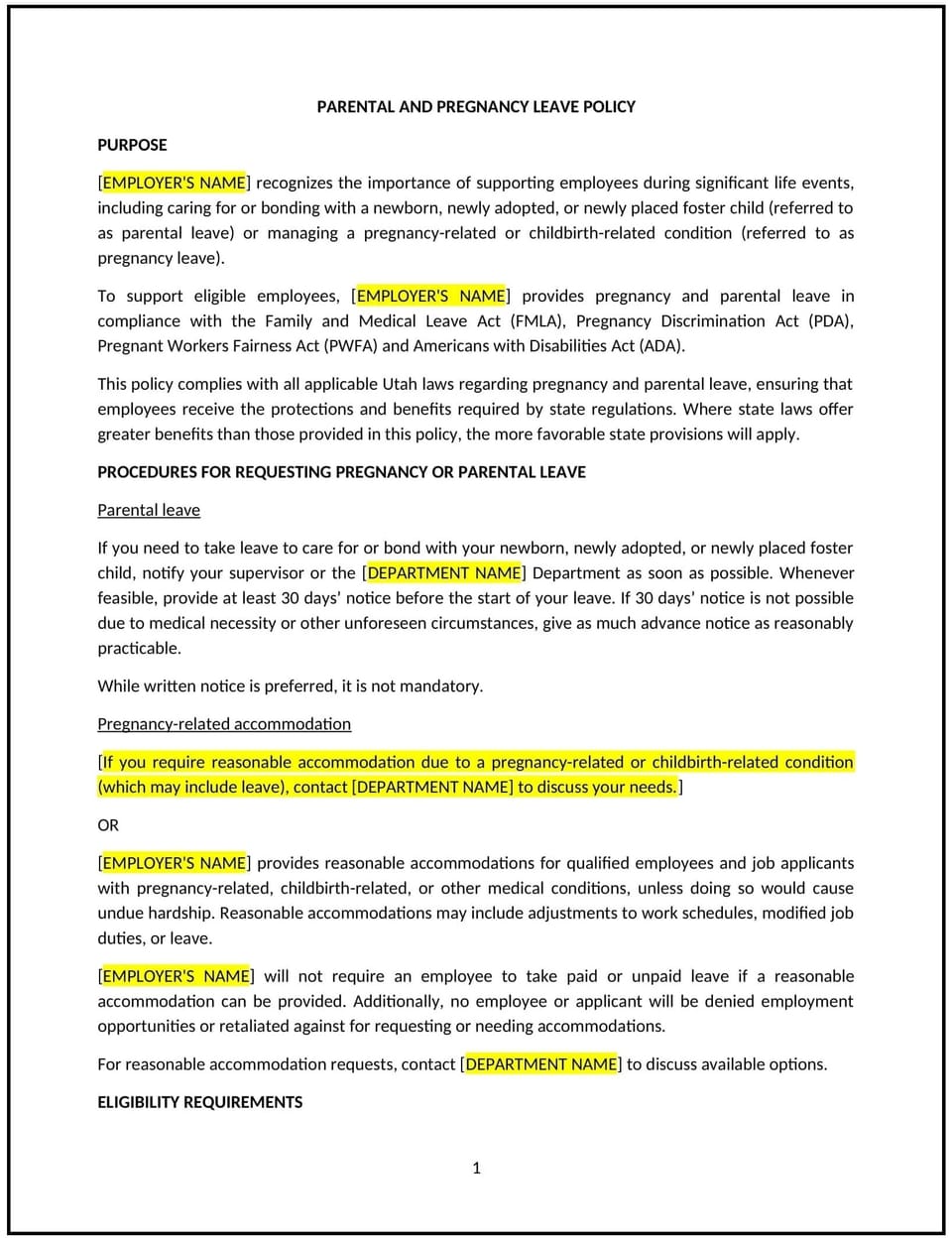Parental and pregnancy leave policy (Utah): Free template

Parental and pregnancy leave policy (Utah)
This parental and pregnancy leave policy is designed to help Utah businesses support employees during pregnancy, childbirth, adoption, or foster care placement. It outlines procedures for granting leave, job protection, and benefits during parental leave.
By adopting this policy, businesses can comply with federal and state laws, support employee well-being, and align with general best practices for leave management.
How to use this parental and pregnancy leave policy (Utah)
- Define leave types: Specify the types of leave covered, such as pregnancy leave, maternity/paternity leave, or adoption leave.
- Establish eligibility criteria: Outline which employees are eligible for parental leave, such as full-time or part-time staff.
- Set leave duration: Define the maximum amount of leave employees can take, typically up to 12 weeks under the Family and Medical Leave Act (FMLA).
- Address job protection: Guarantee that employees will return to the same or an equivalent position after parental leave.
- Provide benefits: Clarify whether employees will continue to receive benefits, such as health insurance, during leave.
- Train managers: Educate supervisors on handling parental leave requests and maintaining workflow during employee absences.
- Review and update: Assess the policy annually to ensure it aligns with evolving laws and business needs.
Benefits of using this parental and pregnancy leave policy (Utah)
This policy offers several advantages for Utah businesses:
- Supports employee well-being: Demonstrates a commitment to helping employees balance work and family responsibilities.
- Aligns with legal standards: Helps businesses comply with federal and state laws, such as the Family and Medical Leave Act (FMLA).
- Enhances retention: Provides job security during leave, reducing turnover and retaining experienced employees.
- Promotes inclusivity: Supports employees during significant life events, fostering a positive workplace culture.
- Reduces legal risks: Minimizes the risk of non-compliance with leave laws and potential lawsuits.
Tips for using this parental and pregnancy leave policy (Utah)
- Communicate the policy: Share the policy with employees and include it in the employee handbook.
- Provide training: Educate managers on handling parental leave requests and maintaining workflow during employee absences.
- Monitor compliance: Regularly review parental leave requests to ensure adherence to the policy.
- Address issues promptly: Take corrective action if parental leave requests are mishandled or denied improperly.
- Update regularly: Assess the policy annually to ensure it aligns with evolving laws and business needs.
Q: How does this policy benefit businesses?
A: By supporting parental and pregnancy leave, businesses can enhance employee well-being, comply with legal standards, and improve retention.
Q: What types of leave are typically covered?
A: Covered leave may include pregnancy leave, maternity/paternity leave, adoption leave, or foster care placement leave.
Q: Should parental leave be paid or unpaid?
A: Parental leave is typically unpaid under the Family and Medical Leave Act (FMLA), but businesses may choose to offer paid leave as a benefit.
Q: What should businesses do if an employee’s leave extends beyond the expected duration?
A: Businesses should maintain open communication with the employee and adjust workflow as needed.
Q: How often should businesses review this policy?
A: Businesses should review the policy annually or as needed to ensure it aligns with evolving laws and business needs.
This article contains general legal information and does not contain legal advice. Cobrief is not a law firm or a substitute for an attorney or law firm. The law is complex and changes often. For legal advice, please ask a lawyer.


